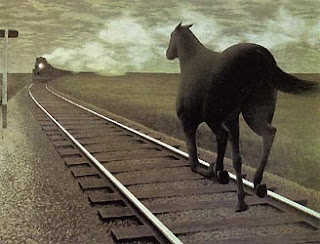Horse and Train
c 2022 Bruce L. Greene
Horse and Train
The image is powerful. In its simplicity is an astonishing complexity. It held me much as Pecola Breedlove from Toni Morrison’s The Bluest Eye was frozen looking at a black cat with blue eyes. But this was no animal. It was a painting. In fact a fairly famous painting entitled Horse and Train. The work of Canadian artist Alex Colville, Horse and Train has rightfully earned it’s reputation as “the Mona Lisa of Hamilton, Ontario where it resides.
I was not in an art gallery, much less in Canada. I first saw the painting in the small box of a cubicle in the counselor’s office of El Cerrito High School. Apparently, I’d missed the painting when it appeared in the film The Shining hanging in the doctor’s office. “I see you can’t take your eyes off that painting,” said George, the counselor in whose office I waited. We’d done many parent-student, counselor, and teacher conferences over the years and grown to be good friends. Visits with George were always worthwhile. Aside from his stellar sense of humor, George possessed keen observation skills and an abundance of empathy. Students validated his importance to our school culture daily. Within minutes, the conference attendees were all in place and not another word that day was spoken about that painting that had so enthralled me.
I don’t think we ever spoke about that painting again. That’s because there was always something else to share with George while waiting for folks to show up. Typical topics included the music of Hank Williams, good red wines under 20 dollars, or the latest book, film, or restaurant that impressed each other. But Horse and Train remained a strong influence in my life. Acting like a Zen koan. I found myself returning to the painting time and again because it touched something deep within.
I liked the tension. A beautiful horse in full flight on railroad tracks with an ominous locomotive rounding a bend and bearing down from the opposite direction. The symbolism was obvious, but a quick look at what inspired the artist reveals even more. Alex Colville used a couplet from a poem by South African poet Roy Campbell as his chief inspiration:
Against a regiment, I oppose a brain
and a dark horse against an armored train.
I’ve often wondered what George’s intention was in hanging a print of the painting above his desk in the Counselor’s office. How many students in a 35-year career might have pondered this disquieting image? Was this part of George’s master plan in aiding students to make difficult decisions in their lives?
We never had that conversation, because we didn’t need to. Whenever I mentioned the painting to my colleagues, they assumed my attraction to it was linked to the fact that both horses and trains have played major roles in my life. Throughout my long teaching career, I’d dabbled in other interests. Out of love for these topics, I’d produced a couple of radio programs, oral histories, one on hobos and rail riders, the other on the sub-culture of horse racing. I loved studying the history, doing the interviews, and then editing them and mixing them with traditional music about similar themes. But, no, that painting was much more than that simple explanation. Horses were a standard of beauty for me. Armored trains represented all those immoveable forces that I’d come up against in this lifetime. To those who told me that they were disturbed by the notion of a horse heading toward certain death by colliding with a train,I can only offer that in my view, no horse would do that. Even in full flight, they can and would swerve away. Of that I am certain.

Comments